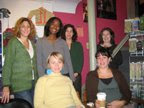 Everyone--really, everyone--was wearing wonderful handknit stuff. Unfortunately, all of the pictures were blurry except this one of Sherry wearing Geyl and Jim wearing a sweater he designed.
Everyone--really, everyone--was wearing wonderful handknit stuff. Unfortunately, all of the pictures were blurry except this one of Sherry wearing Geyl and Jim wearing a sweater he designed.So you should just imagine Wendy in her turtleneck-with-sleeves (sleeves-with-turtleneck?) from Wrap Style, Karen in the Half-Square Shawl, Barb with an Alligator Wrap, and Christina wearing--hey, Chris, what is that scarf? I can tell it's Noro, but I can't see any more than that.
The cast-on is definitely the trickiest part. We tried a couple variations. Eventually, everyone got it, and repeated it enough times to feel like they'd still know how to do it when they got to the second sock.
Working the entrelac was no big deal--working entrelac never is. It's easier in the round, because you don't have to worry about side triangles. This particular pattern has a couple unusual characteristics: in most entrelac, the first stitch of every row is slipped, but not here. Eunny Jang, the designer, says that the slipped stitches decrease elasticity. A couple people experimented with doing it either way and they found no difference. The slipped stitches make it easier to pick up the right number when starting the next block, though, and working all the stitches (rather than slipping them) seems to lead to gaps along the picked-up edge. So some people are choosing to slip them anyway.
Second, on each round, the stitches for the first block are picked up in the reverse direction as all the other blocks. That is, if the whole round is going to be full of blocks picked up purlwise, the first block is picked up knitwise. And vice versa. This seems to be a function of where the yarn ends up at the end of the previous tier, and facilitates carrying the yarn up the inside of the sock rather than cutting and rejoining it every time. That's a worthwhile change, though a little confusing at first.
From here, it should be smooth sailing for all until the heel begins.
Here's a picture of Wendy's toe and Courtney's. They've both got the same Koigu multi. Wendy's olive solid is Reynolds' Sea Wool, and Courtney's mustard is a solid Koigu.
 Stay tuned for more!
Stay tuned for more!



1 comment:
Completely off-topic but thought you should see the Knitter's Review of Shokay http://www.knittersreview.com/article_yarn.asp?article=/review/product/070322_a.asp
We bought this in December at Rosie's as your project of the month. Turns out a ribbed hat is highly recommended!
Post a Comment